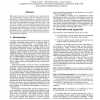Free Online Productivity Tools
i2Speak
i2Symbol
i2OCR
iTex2Img
iWeb2Print
iWeb2Shot
i2Type
iPdf2Split
iPdf2Merge
i2Bopomofo
i2Arabic
i2Style
i2Image
i2PDF
iLatex2Rtf
Sci2ools
AVSS
2005
IEEE
2005
IEEE
VidMAP: video monitoring of activity with Prolog
This paper describes the architecture of a visual surveillance system that combines real time computer vision algorithms with logic programming to represent and recognize activities involving interactions amongst people, packages and the environments through which they move. The low level computer vision algorithms log primitive events of interest as observed facts, while the higher level Prolog based reasoning engine uses these facts in conjunction with predefined rules to recognize various activities in the input video streams. The system is illustrated in action on a multi-camera surveillance scenario that includes both security and safety violations.
Activities Involving Interactions | AVSS 2005 | Computer Vision Algorithms | Multi-camera Surveillance Scenario | Signal Processing |
| Added | 24 Jun 2010 |
| Updated | 24 Jun 2010 |
| Type | Conference |
| Year | 2005 |
| Where | AVSS |
| Authors | Vinay D. Shet, David Harwood, Larry S. Davis |
Comments (0)

